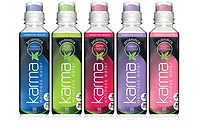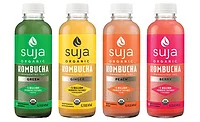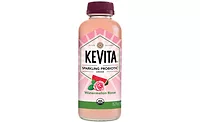Functional beverages containing probiotics trend upwards
44% of consumers consider using probiotics, Kerry global survey discovers
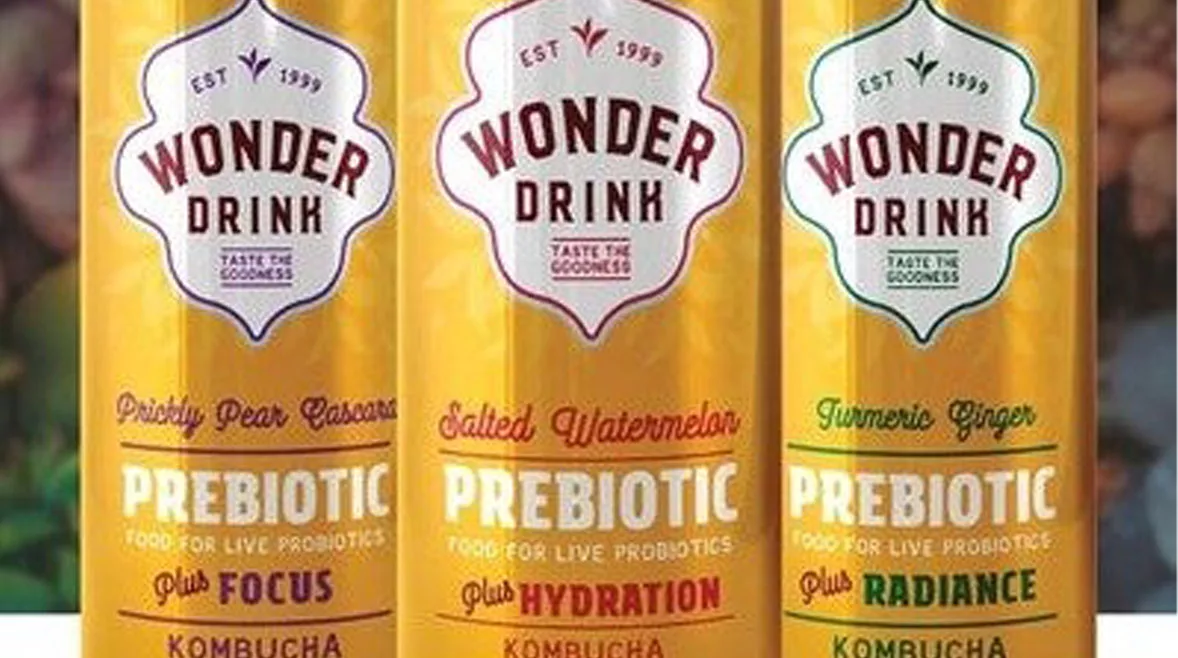
Image courtesy of Wonder Drink
The idiom “what’s good for the goose is good for the gander” implies that what’s good for the female goose also is good for the male goose. In the expanding world of functional beverages, products containing the three Ps — prebiotics, probiotics and postbiotics — are doing “better than their best” for males and females of all ages wishing to improve their digestive health and boost immunity.
In fact, in 2020 the probiotics category and products with a probiotic or digestive health claim accounted for 34% of total North American functional beverage launches, and 23% of total Latin American functional beverage launches, states John Quilter, vice president of the global portfolio for proactive health at Kerry.
Conducted in January 2021 by the Beloit, Wis.-based company, a global survey of 13,000 consumers across 16 countries on probiotics and digestive health found that one in four consumers globally (25%) had used a probiotic-containing product in the previous six months (up from 21% in 2019). When it comes to awareness, 47% of respondents were aware of probiotics or cultures, an increase from the previous year's survey (45%). Furthermore, 25% of consumers surveyed had used a probiotic-containing product in the previous six months (up from 21% in 2019). The survey identified that 44% would consider using probiotics, up from 40% in 2019.
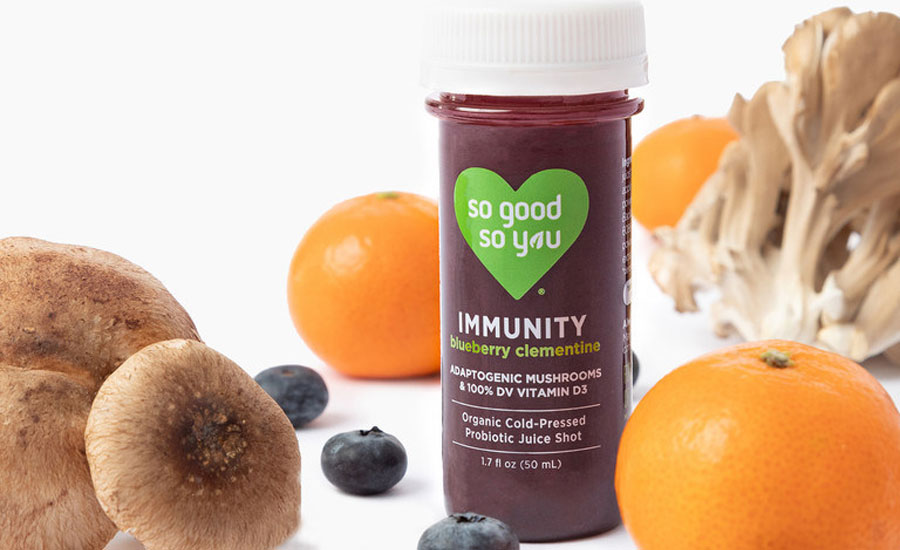
Images courtesy of So Good So You
Plant-based probiotics
Nandini Roy Choudhury, client partner for food and beverage at Future Market Insights (FMI), Dubai, India, notes that plant-based diets account for a significant proportion of dietary choices in developed countries like Canada and the United States, as well as developing countries like India, where 20-40% of the population consumes vegan food.
“As consumer preferences have shifted, several juice brands are now offering plant-based probiotic drinks. For instance, in 2021, U.S.-based start-up Yoi has launched a line of plant-based probiotic drinks,” she says. “Over the last decade, the organic movement has taken the food and beverage industry by storm. Kombucha brands, on the other hand, are still catching up with the trend. To meet the growing demand for organic food items, manufacturers must state the origin of the materials used in their kombucha and indicate whether they are organic.”
When it comes to the type of probiotics used, science-backed ingredients resonated higher. “Evidence points to very high levels of awareness of the gut health benefits of probiotics,” Kerry’s Quilter explains. “For example, in our 2021 global consumer survey, we showed respondents the logo for BC30 (our science-backed probiotic ingredient) and an image of products in which it can be found. When asked which benefits they perceived BC30 to deliver, 45% identified digestive health.
“The area where consumer knowledge could still be improved is on the huge differences between different strains,” he continues, “Not all probiotic ingredients are created equal, and not all are backed by science.”
Due to its functionality, probiotics and probiotic supplements continue their upward momentum. The global probiotics market was estimated at $54.77 billion in 2020 and is anticipated to grow at a compound annual growth rate (CAGR) of 7.2% from 2021 to 2028, according to Grandview Research.
Additionally, the probiotic supplements market is anticipated to outpace total supplements with a CAGR of 3.7% during 2021-2026, says Micah Greenhill, beverage marketing director for ADM, Chicago.
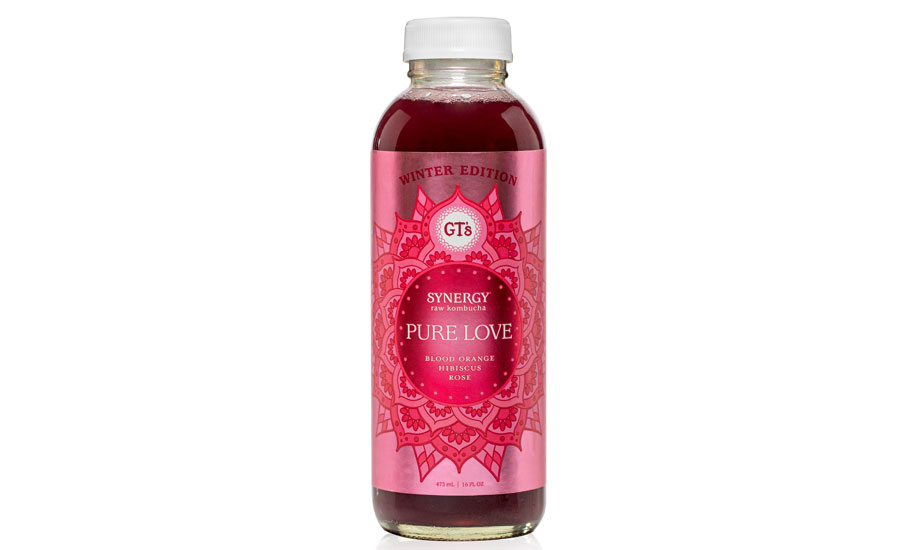
Image courtesy of GT’s Living Foods
The global pandemic has fostered greater interest in health and wellness, and experts laud social media as playing a big role in educating consumers and showcasing a variety of dietary supplements and other products that deliver functional benefits.
“On TikTok, the hashtag for probiotics touts over 107 million views alone, not including views on varied hashtags,” explains Erin Costello, communications and events associate at Niles, Ill.-based Imbibe. “While many of the short-form videos include DIY recipes for probiotic beverages, this gave opportunity for brands to have an inside look at what consumers are looking for from their products and a place to add sponsored posts and advertisements while people were spending their time at home on their phones. We’ve also seen 30% growth of #probiotics on Instagram, between August 2020 and January 2022.”
Sayantan Paul, senior food scientist for Minneapolis-based Spoonshot, concurs that social media is contributing to consumer interest in probiotics, which has grown by 30.6% in the past five years.
“Factors like age, stress, poor diet, which lead to digestive ailments, reduced immunity and bloating, have led to the use of probiotic beverages,” Paul says. “Also, consumer interest around gut health grew by 148% since 2016, and gut health also is among the Top 5 health-related topics in online social media conversations, with a 6.4% share in those conversations.
“Based on our social media analysis, consumers are looking at the following health benefits from probiotic foods: gut health, detoxification, anti-inflammatory, antioxidant and weight loss,” he continues. “Based on the products analyzed, probiotics appear in 54% of products whereas 46% of products have prebiotics. Unlike probiotics, which are live bacteria, postbiotics contain the metabolites that they produce — essentially one of the main reasons bacteria have a ‘job’ and are so beneficial to our body. Getting postbiotics in your gut is the ultimate goal when eating or supplementing with probiotics.”
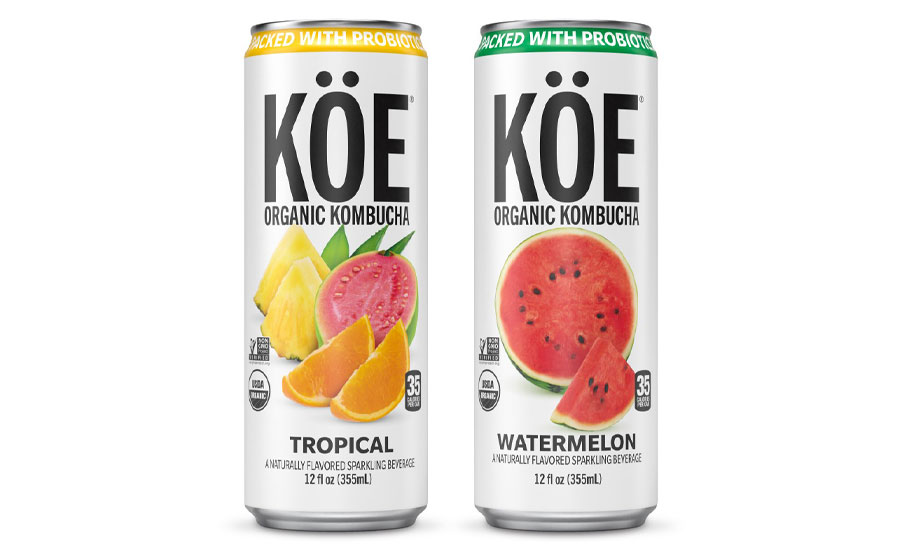
Image courtesy of KÖE Kombucha
Ingredient differences defined
Prebiotics, probiotics and postbiotics can help support gut microbiome and aid digestive and immune health given that around 70% of one’s immune health is stored in the gut, explains FMI’s Roy Choudhury.
“Digestive health is becoming more diverse,” she says. “Probiotics and prebiotics have powerful immune-boosting properties. Kombucha is a probiotic drink that aids in the balance of gut flora, allowing for the regularization of intestinal activities. The multi-beneficial properties of probiotics drive the usage of probiotics in the beverage industry.”
In addition to maintaining gut health, promoting weight loss and enhancing cognitive function, probiotics also are linked to improved libido, Imbibe’s Costello says. “Ninety-five percent of the happy hormone, serotonin, lives in our gut after all,” she notes.
Yet, consumers continue to be confused about the differences between prebiotics, probiotics and postbiotics, particularly because they have distinctly different functions and origins. Roy Choudhury outlines the differences as follows:
- Probiotics: The most commonly used ingredient in the food and beverage industry as compared with prebiotics and postbiotics, probiotics are cultures of live bacteria and yeast that can be found in functional foods and beverages such as yogurt and kombuchas.
- Prebiotics: Foods that promote the growth of beneficial bacteria in your gut are known as prebiotics or dietary fibers. They are found naturally in high-fiber foods like bananas, asparagus, apples, yams and barley. Because our bodies are unable to break down digestive fiber, it remains in your lower intestines and fuels the growth of good bacteria and other microbes.
- Postbiotics: As opposed to probiotics, postbiotics contain the metabolites that bacteria produce — essentially one of the main reasons bacteria have a “job” and are so beneficial to your body. When eating or supplementing with probiotics, the ultimate goal is to get postbiotics in your gut because they help support one’s gut microbiome all year long.
Across Chicago-based SPINS LLC Natural Enhanced and Conventional Channels for the 52 weeks ending Nov. 28, 2021, data for probiotics and prebiotics within beverages reported some significant differences. On the prebiotics side, shelf-stable soda and carbonated beverages garnered a year-over-year (YoY) increase of nearly 326%, while refrigerated kombuchas and fermented beverages were up 260.5% and shelf-stable flavored sparkling water saw a YoY increase of 209.2%.
No. 1, with a 390.6% upswing, were shelf-stable performance categories. All of the beverages containing prebiotics in SPINS’ measured channels, including refrigerated RTD teas, coffees and juices along with their shelf-stable counterparts, were up 19.6%.
For the same timeframe, shelf-stable energy drinks and other functional beverages containing probiotics were the top sales drivers with 4,357.4% growth. Unlike beverages containing prebiotics, shelf-stable soda and carbonated beverages were only up 12.8%. Shelf-stable RTD tea and coffee were up 510%, while their refrigerated counterparts saw a deceleration of nearly 73%. Total beverages containing probiotics were essentially flat at 0.3%, SPINS data reports.
Although probiotics have maintained growth over the past year, prebiotics are growing at a much larger rate, explains Haleigh Resetar, SPINS’ corporate communications specialist.
“Some of the most popular probiotic drinks are shelf-stable functional beverages in the energy and performance subcategories,” she says. “Many brands interested in producing products with probiotics may start in this subcategory because it targets a group of consumers who are already interested in health and wellness, and aware of the benefits. Functional carbonated beverages offering prebiotics to improve digestion are some of the top contributors to this ingredient’s growing popularity.”
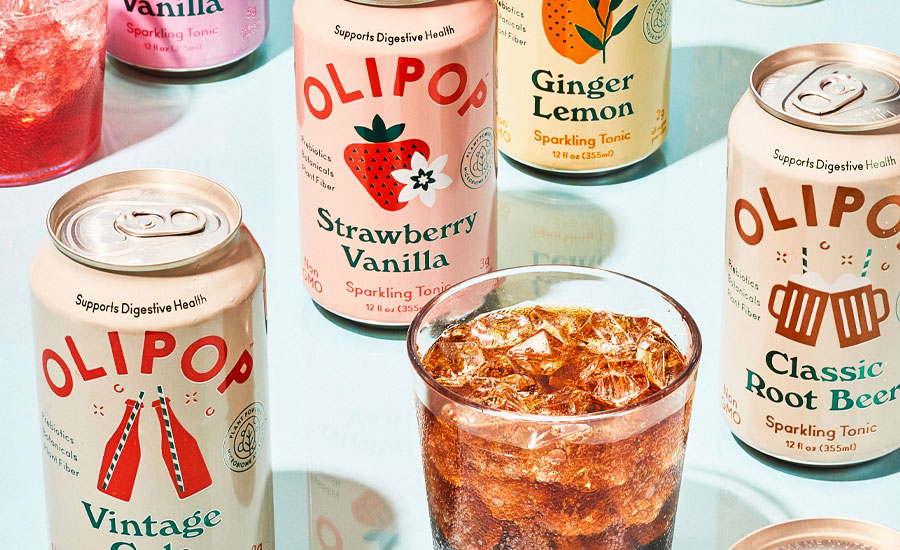
Image courtesy of OLIPOP
San Francisco-based OLIPOP is a functional low-calorie, low-sugar beverage that combines the benefits of prebiotics, plant fiber and botanicals in a “New Kind of Soda” that promotes digestive health. The fizzy, functional OLIPOP is available in seven flavors. Each 12-ounce drink contains 35-45 calories, has as little as 2 grams of sugar and helps support one’s microbiome and digestive health, the company says.
Going forward, Spoonshot’s analysts predict that consumer and business interest in probiotics will continue to grow. Paul also expects innovation within the probiotics category to expand as more applications containing science-backed ingredients come to the forefront. (See sidebar).
“Although the preferred medium for the application of probiotics is dairy foods, interest in the other categories is rising as consumers want to avail themselves of gut and digestive health benefits from various types of foods,” he explains. “Consumer interest in gut health is expected to rise by 24% in the next 12 months, while business interest is expected to grow by 5.5%.”
The science of bacteria
Experts note that studying the living bacteria that adds to population of “good bacteria,” or probotics, is important to ensure the efficacy of the ingredients.
John Quilter, vice president of the global portfolio for proactive health at Kerry, Beloit, Wis., notes that its BC30, a leading spore-forming probiotic, is backed by a wealth of scientific evidence including more than 25 published papers on a range of different demographic groups and has been clinically shown to support digestive health, immune health and protein absorption. Most recently, a double-blind randomized, controlled crossover study added to the body of evidence that it can increase amino acid absorption into the bloodstream, he adds.
Likewise, Micah Greenhill, beverage marketing director for ADM, Chicago, notes that the food processing company continually is researching and identifying microbial strains that can help support growth and solve any formulation issues that may arise.
“For instance, our award-winning BPL1 (Bifidobacterium animalis subsp. lactis CECT 8145) probiotic and its heat-treated postbiotic counterpart, HT-BPL1, help meet consumers’ wellness goals by targeting factors relevant to metabolic health,” Greenhill explains. “As a postbiotic, HT-BPL1 contains non-viable microorganisms, which means it can retain stability in a variety of formulation environments, making it an innovative solution for beverages. Moreover, spore-forming probiotics can also survive harsh processing conditions that may damage conventional lactic acid bacteria-based probiotics.
“Our spore-forming probiotic, DE111 (Bacillis subtilis), helps beverage formulators target different consumer needs, and it has been studied in nine human clinical trials related to digestive health, immune health and more,” he continues. “Due to their ability to remain stable, our HT-BPL1 and DE111 strains provide product developers with cutting-edge solutions for beverages in a wider array of formats, such as yogurt drinks, sports beverages and functional juices and waters.”
Sayantan Paul, senior food scientist for Minneapolis-based Spoonshot, cautions that using standard probiotics, which are heat-labile, in frozen products is difficult. They also are affected by the carbon dioxide in carbonated beverages.
“Some techniques used for overcoming these formulation challenges are pre-adapting cells to sub-lethal temperatures or salt treatments, immobilization techniques, microencapsulation techniques to make them heat/pH tolerant,” he says. “Probiotics are also added in foods after heat treatment to overcome these difficulties.”
In the future, Paul suggests that more beverage manufacturers will work with postbiotics as they are heat-resistant and long-lasting at ambient temperatures.
Looking for a reprint of this article?
From high-res PDFs to custom plaques, order your copy today!



